Introduction
This chapter provides information needed to determine good renewable energy prospects on Indian tribal lands. It begins with a series of maps showing U.S. renewable energy resources and the Nation's electricity grid with an overlay of Indian tribal land boundaries. Following the maps is an assessment by individual tribal land of the premium for each renewable electricity resource over the cost of purchased electricity. The results include two lists of sites for further investigation. One shows Indian lands where the marginal cost of renewable energy over current wholesale electricity cost was least; the other shows the highest percentage of tribal members without electricity.
Because renewable energy availability tends to be highly site-specific and because there are often restrictions and other considerations on land use for renewable energy projects, it is essential to conduct individual project and site analyses before beginning any project. This chapter provides an outline for this process following the data on renewable electricity costs and concludes with a discussion of limitations in developing renewable resources.
Renewable Resources on Indian Lands
| Figure 10. Federal and Oklahoma Indian Lands |

|
Federal and Oklahoma Indian tribal lands are located primarily in the western United States (Figure 10). This also tends to be where renewable resources are located. Maps of solar/photovoltaic, concentrated solar power, wind, biomass, and geothermal resources are shown overlaying tribal land boundaries (Figures 11-15). For hydropower, no map-friendly source of resource potentials was readily available. Therefore, EIA developed a generic assessment of new hydroelectric plant costs, based on studies conducted by the Department of Energy's Idaho National Engineering and Environmental Laboratory (INEEL). Finally, the potential for renewable resources--particularly for selling renewable power into the grid--is strongly influenced by access to transmission lines, transmission line capability, and transmission line load (Figure 16). Figure 16 shows transmission and location information. Unfortunately, no comprehensive source of data on transmission line load exists.
A major caveat exists in applying resource estimates to small land area reservations. Resources are estimated either at the county level or some other small grid level (e.g., 25 by 25 miles for solar). However, some reservations are much smaller than this grid size. In those cases, it is quite possible that either the resources listed are not actually on the reservation (e.g., biomass) or there are small-area considerations that make the resource not viable on the reservation.
Federal and Oklahoma Indian Lands
The map showing the boundaries of Federally Recognized
American Indian Reservations and Tribal Jurisdictional Statistical Areas (in
Oklahoma) indicates the areas that are the subject of this report. It is derived
from a similar one available from the U.S. Department of the Interior, Bureau of
Indian Affairs, Geographic Data Service Center (GDSC). A series of Indian maps are
available on the GDSC website:
http://www.gdsc.bia.gov/products/default.htm.
Underlying data is based on the U.S. Department of Commerce, Bureau of Census, 1992
Tiger Line Files.
Solar Resources for Flat Plate Collectors
Figure 11 provides monthly average daily total solar resource information on grid cells of approximately 40 km by 40 km in size. The insolation values represent the resource available to a flat plate collector, such as a photovoltaic panel, oriented due south at an angle from horizontal equal to the latitude of the collector location. This is common practice for PV system installation, although other orientations are also used. The map was developed from the Climatological Solar Radiation (CSR) Model. The CSR model was developed by the National Renewable Energy Laboratory for the U.S. Department of Energy.(1),(2) This model uses information on cloud cover, atmospheric water vapor and trace gases, and the amount of aerosols in the atmosphere, to calculate the monthly average daily total insolation (sun and sky) in units of kilowatthours per meter squared per day (kWh/m2/day) falling on a horizontal surface. The cloud cover data used as input to the CSR model are an 8-year histogram (1985-1992) of monthly average daily cloud fraction provided for grid cells of approximately 40 km x 40 km in size. Thus, the spatial resolution of the CSR model output is defined by this database. The data are obtained from the National Climatic Data Center in Asheville, North Carolina, and were developed from the U.S. Air Force Real Time Nephanalysis (RTNEPH) program. Atmospheric water vapor, trace gases, and aerosols are derived from a variety of sources, as summarized in the references. The procedures for converting the modeled global horizontal insolation into the insolation received by a flat plate collector at latitude tilt are described in Marion and Wilcox (1994).(3)
| Figure 11. Solar Photovoltaic (PV) Resource Potential |
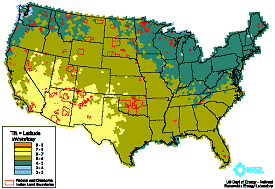
|
Because the resource data are for a non- tracking system, the available resource tends to be lower than for concentrating systems in sunny areas, but higher in cloudy areas. This is because under cloudy conditions PV systems can still convert the sky radiation to useable electricity, whereas concentrators shut down completely when the sun is obscured by clouds.
Where possible, existing ground measure- ment stations are used to validate the model. Nevertheless, there is uncertainty associated with the meteorological input to the model, since some of the input parameters are not available at a 40-km resolution. As a result, it is believed that the modeled values are accurate to approximately 10 percent of a true measured value within the grid cell. Due to terrain effects and other microclimate influences, the local cloud cover can vary significantly even within a single grid cell. Furthermore, the uncertainty of the modeled estimates increases with distance from reliable measurement sources and with the complexity of the terrain.
Areas with ratings of at least 5 to 6 kWh/m2/day are required to be considered suitable for development.
Solar Resources for Concentrating Systems
Figure 12 provides monthly average daily total solar resource information on grid cells of approximately 40 km by 40 km in size. The insolation values represent the resource available to concentrating systems that track the sun throughout the day. Such systems include concentrating solar power systems such as trough collectors or dishes. The values are also useful for assessing the resource available to solar hot water systems.
| Figure 12. Concentrated Solar Power (CSP) Resource Potential |
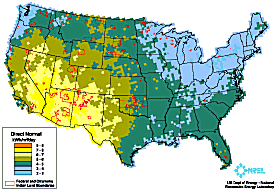
|
The map was developed from the Climato- logical Solar Radiation (CSR) Model. The CSR model was developed by the National Renewable Energy Laboratory for the U.S. Department of Energy.(4), (5) This model uses information on cloud cover, atmospheric water vapor and trace gases, and the amount of aerosols in the atmosphere, to calculate the monthly average daily total insolation) in units of kWh/m2/day falling on a device that tracks the sun throughout the day. The cloud cover data used as input to the CSR model are an 8-year histogram (1985-1992) of monthly average daily cloud fraction provided for grid cells of approximately 40 km x 40 km in size. Thus, the spatial resolution of the CSR model output is defined by this database. The data are obtained from the National Climatic Data Center in Asheville, North Carolina, and were developed from the U.S. Air Force Real Time Nephanalysis (RTNEPH) program. Atmospheric water vapor, trace gases, and aerosols are derived from a variety of sources, as summarized in the references. Because the resource data are for a tracking system, the available resource tends to be higher than for non-tracking systems in sunny areas, but lower in cloudy areas. This is because under cloudy conditions tracking systems are unable to use any of the solar resource, which is obscured, while flat plate collectors can still make use of the sky radiation that is still available.
Where possible, existing ground measurement stations are used to validate the model. Nevertheless, there is uncertainty associated with the meteorological input to the model, since some of the input parameters are not available at a 40-km resolution. As a result, it is believed that the modeled values are accurate to approximately 10 percent of a true measured value within the grid cell. Due to terrain effects and other microclimate influences, the local cloud cover can vary significantly even within a single grid cell. Furthermore, the uncertainty of the modeled estimates increases with distance from reliable measurement sources and with the complexity of the terrain. Concentrating solar collectors are much more sensitive to solar resource characteristics than flat plate collectors, so that these sources of uncertainty are more important to concentrator applications.
Areas with ratings of at least 5 to 6 kWh/m2/day are required to be considered suitable for development.
Wind Resources
The national wind resource assessment of the United States was created for the U.S. Department of Energy in 1986 by the Pacific Northwest Laboratory and is documented in the Wind Energy Resource Atlas of the United States, October 1986. The atlas can be viewed on the Internet at http://rredc.nrel.gov/wind/pubs/atlas.
The wind resource assessment was based on surface wind data, coastal marine area data and upper-air data, where applicable. In data-sparse areas, three qualitative indicators of wind speed or power were used when applicable: topographic/meteorological indicators (e.g. gorges, mountain summits, sheltered valleys); wind deformed vegetation; and eolian landforms (e.g. playas, sand dunes). The data were evaluated at a regional level to produce 12 regional wind resource assessments, the regional assessments were then incorporated into the national wind resource assessment.
| Figure 13. Wind Resource Potential |
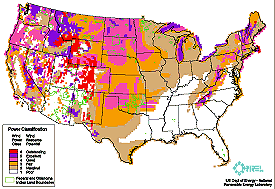
|
The conterminous United States was divided into grid cells 1/4 degree of latitude by 1/3 degree of longitude (or approximately 18 by 24 miles). Each grid cell was assigned a wind power class ranging from 1 to 7, with 7 being the windiest. The wind power density limits for each wind power class is shown in Table 3. Each grid cell contains sites of varying power class. The assigned wind power class is representative of the range of wind power densities likely to occur at exposed sites within the grid cell. Hilltops, ridge crests, mountain summits, large clearings, and other locations free of local obstruction to the wind are expected to be well exposed to the wind. In contrast, locations in narrow valleys and canyons, downwind of hills or obstructions, or in forested or urban areas are likely to have poor wind exposure. Areas designated class 4 or greater are suitable for most utility-scale wind turbine applications, whereas class 2 and 3 areas are marginal for utility-scale applications but may be suitable for rural applications. Class 1 areas are generally not suitable, although a few locations (e.g., exposed hilltops not shown on the maps) with adequate wind resource for wind turbine applications may exist in some class 1 areas. The degree of certainty with which the wind power class can be specified depends on three factors: the abundance and quality of wind data; the complexity of the terrain; and the geographical variability of the resource. A certainty rating was assigned to each grid cell based on these three factors, and is included in the Wind Energy Resource Atlas of the United States.
| Table 3. Classes of Wind Power Density at Heights of 10 m and 50 m (a) | ||||
|---|---|---|---|---|
| Wind Power Class* | 10 m (33 ft) | 50 m (164 ft) | ||
| Wind Power Density (W/m2) | Speed(b) m/s (mph) | Wind Power Density (W/m2) | Speed(b) m/s (mph) | |
| 1 | 0 | 0 | 0 | |
| 100 | 4.4 (9.8) | 200 | 5.6 (12.5) | |
| 2 | 150 | 5.1 (11.5) | 300 | 6.4 (14.3) |
| 3 | 200 | 5.6 (12.5) | 400 | 7.0 (15.7) |
| 4 | 250 | 6.0 (13.4) | 500 | 7.5 (16.8) |
| 5 | 300 | 6.4 (14.3) | 600 | 8.0 (17.9) |
| 6 | 400 | 7.0 (15.7) | 800 | 8.8 (19.7) |
| 7 | 1,000 | 9.4 (21.1) | 2,000 | 11.9 (26.6) |
| a Vertical
extrapolation of wind speed based on the 1/7 power law. b Mean wind speed is based on Rayleigh speed distribution of equivalent mean wind power density. Wind speed is for standard sea-level conditions. To maintain the same power density, speed increases 3%/1000 m (5%/5000 ft) elevation. * Note: Each wind power class should span two power densities. For example, Wind Power Class = 3 represents the Wind Power Density range between 150 W/m2 and 200 W/m2. The offset cells in the first column attempt to illustrate this concept. |
||||
Biomass Resources
Figure 14 provides county-level estimates of biomass resources available for biofuels production or biomass power stations. The map includes only those resources available from crop and forest residues. It does not include managed crop or forest resources, urban residues, municipal solid waste (MSW) or landfill gas (LFG).
| Figure 14. Biomass and Biofuels Resource Potential |

|
The biomass resource data were derived from several sources. One of the sources was an NREL contracted study of crop residue for 36 eastern States. The data are based on a 3-year average of corn and wheat residue available for energy, taking into account tillage practices and rainfall erosion deterrence. The units for the original data were in dry tons per county. These were converted to total kilowatts per county by assuming that one dry ton is equivalent to 1,100 kW-hr/yr at a 65-percent plant capacity factor and a 35-percent plant conversion efficiency. This study only included the eastern 36 States where data were available. For a few of these 36 States, county level data were missing for a few counties. The report is in draft form, titled "Corn Stover and Wheat Straw Removal Analysis" by Richard G. Nelson.
The forest residue data were derived from the forest inventory and analysis unit of the USDA Forest Service Timber Product Output database retrieval system (see http://srsfia.usfs.msstate.edu/rpa) web site. The data used from this site were county level data for the conterminous United States. The 1996 data included were logging and mill residues, and other removals (pre-commercial thinnings, land clearing, timber stand improvements, etc.). The logging residue and other removals data were converted into potential kilowatts per county from thousand cubic feet. This was done by assuming that one thousand cubic feet of residue is equivalent to 14 dry tons, and a dry ton is equivalent to 1,100 kW-hr/yr at a 65-percent plant capacity factor and a 35-percent plant conversion efficiency. The mill residue was converted directly from thousand dry tons into potential kilowatts per county.
A resource potential greater than 5,000 kilowatts per county would be required to be a candidate for development.
Geothermal Resources
| Figure 15. Geothermal Resource Potential |
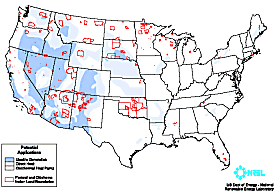
|
The map for geothermal resource potential was derived from data obtained from the Southern Methodist University Geothermal Laboratory, Dallas, TX.(6) The resource estimates are based on heat flow rates, which are determined by multiplying the thermal gradient in degrees Kelvin per kilometer (0K/km) and the thermal conductivity in watts per meter degrees Kelvin (W/m-0K).(7)
Geo-referenced data of heat flow in units of mW/m2 (milliwatts per meter squared), provided by the SMU Geothermal Laboratory at a 5-km resolution, were imported into the Geographic Information System (GIS). Contours were then interpolated for intervals of 10 milliwatts/m2. Designations for electric generation, direct use, and ground-source heat pump applications were determined to approximate the maps shown on the State Energy Alternatives web site (http://www.eren. doe.gov/state_energy/index.cfm) as follows: (1) Areas designated as having electric generation potential show heat flow rates ranging from 80 to 151 mW/m2; (2) Areas designated with having direct use potential show heat flow rates ranging from 60 to 80 mW/m2; and (3) Areas with heat flow rates less than 60 mW/m2 are considered appropriate only for ground-source heat pump applications.
Transmission Lines with Federal and Oklahoma Indian Lands
| Figure 16. Transmission Lines with Federal and Oklahoma Indian Lands |
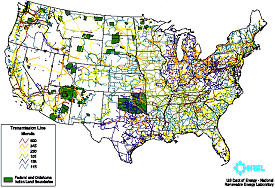
|
Figure 16 data were received from the Federal Energy Management Administration (FEMA) around 1993 and represent a schematic of transmission line connectivity. As such, it can be used appropriately to show whether there is or is not a transmission line of a stated voltage in some given area. But it cannot be used for analysis that would require actual knowledge of easement locations.
Hydropower
While hydropower currently contributes the greatest share of renewable electricity generation in the United States, there are several limitations to its expansion. Rivers provide multiple functions that must be balanced, including electricity production, recreation, fisheries and ecological environments. The characteristics of each location are unique and must be thoroughly evaluated in a public manner before licensing can be achieved. This is particularly true when considering new hydroelectric facilities on Indian lands.
The Department of Energy, through its Idaho National Engineering and Environmental Laboratory (INEEL), in conjunction with the ORNL, developed a computer model to perform a State-by-State assessment of undeveloped hydropower potential, based upon the Federal Energy Regulatory Commission's (FERC) Hydroelectric Power Resources Assessment database and other sources.(8) The model takes into consideration various, cultural, fishery, geologic, historic, recreational, scenic and other environmental attributes. Based on the attributes of each site, a suitablility factor for development is assessed. For the purposes of this study, it is critical to note that the model was developed to create regional totals and is not intended to provide definitive estimates for specific sites.
The DOE hydropower program has estimated the following generic information on hydroelectric developments costs, based on 21 projects completed in 1993:
Average unit size: 31 MW
Capital cost: $1,700 to $2,300 per kW
Operation and maintenance costs: 0.7 cents/kWh
Operating life: 50 or more years
Capacity factor: 40 to 50 percent
Total cost: 2.4 cents per kWh
If these characteristics are used to create a levelized cost using the cost of capital and a 20-year life consistent with the other technologies considered in this report, the total cost ranges from 5.2 to 8.4 cents per kWh. In contrast, DOE estimated that levelized total costs were 2.4 cents per kWh. Part of the reason for their lower levelized cost compared to estimate is likely due to the consideration of an economic recovery period of 50 years rather than 20 years. This alone cannot account for the entire difference, however, so a much lower cost of capital, such as 3 percent real annualized cost, must have been used to achieve its levelized total cost estimate of 2.4 cents per kWh.
As another point of comparison, FERC assumes a 30-year life in its hydropower licensing process. Making this assumption along with EIA assumptions on the real cost of capital, the total levelized cost ranges from 4.8 to 7.7 cents per kWh.
Renewable Resources and Development Costs for Indian Lands
General
This section of the report provides an economic assessment of the potential for renewable electricity projects on Indian tribal lands. Results are categorized separately for central station and dispersed applications. These results will be provided after a general description of the methods and data used to arrive at these conclusions. Following the major results is a section providing supporting details, followed by a discussion of Federal and State renewable support programs which could influence the bottom-line economic feasibility of Indian tribal land renewable energy projects. Since the benchmark for central station renewable electricity prices is wholesale electricity prices, the final part of the section contains a discussion of those prices.
General Approach
The renewable resource information provided by the previously shown maps along with cost information isused to determine the best resource by reservation. However, as discussed in the section on Project Criteria that follows, a much more thorough and local evaluation of a resource would need to be conducted before any development decisions could be made.
An estimate of the levelized cost for electricity production from each resource was developed based on renewable technology characteristics assumed by EIA in the Annual Energy Outlook 2000.(9) For each technology type, a capital cost, fixed O&M cost, and variable O&M cost were extracted for the year 2000. The capital costs are assumed to vary regionally based on labor and material cost differentials, while O&M costs are assumed to be the same for all plants of the same type. Additional sources, such as the DOE Office of Energy Efficiency and Renewable Energy/Electric Power Research Institute (EE/EPRI) Renewable Technology Characteristics Characterizations,(10) were consulted as well. In particular, data for geothermal was augmented, as will be described below, because of the site-specific treatment in the AEO2000 modeling framework.
A simple real levelized cost(11) in 1998 cents per kWh was computed for each region and resource class based on a 10-percent real discount rate and a 20-year economic life of equipment, except for hydropower, where equipment life was assumed to be 30 years. No adjustment was made for tax deductions associated with debt interest payments, because these would not be available if the tribes make the investments. Further, since region-specific transmission costs were not known, they were not included. As discussed in the Project Criteria Section, alternative cost of capital and financing assumptions might apply. Any specific project evaluation would also involve a much more sophisticated financial analysis taking into consideration the matching of generation output, demand levels, alternative prices, and the necessary transmission, intertie, and distribution costs.
Highest Potential Renewable Energy Projects
Central Station Generation
Some of the reservations have multiple renewable resource options, whereas others are not well situated for any renewable resource development. Table 4 lists the Indian lands with the greatest potential based on the following:
-
Reservation/renewable resource combinations having the
lowest renewable development cost premium (excluding transmission costs),
excluding hydropower. These are generally based on either wind or biomass; and
- The regional wholesale electricity price (which includes transmission costs)